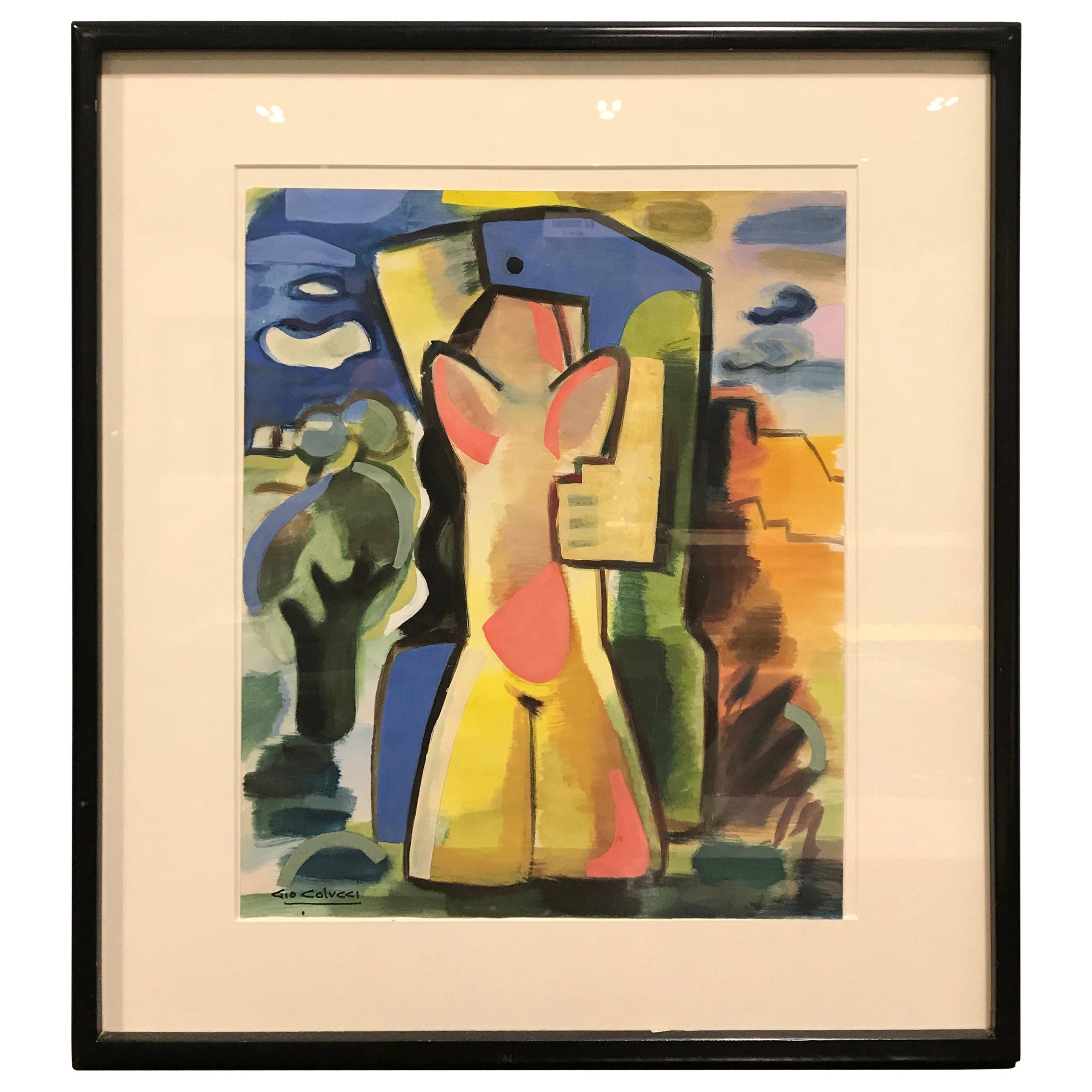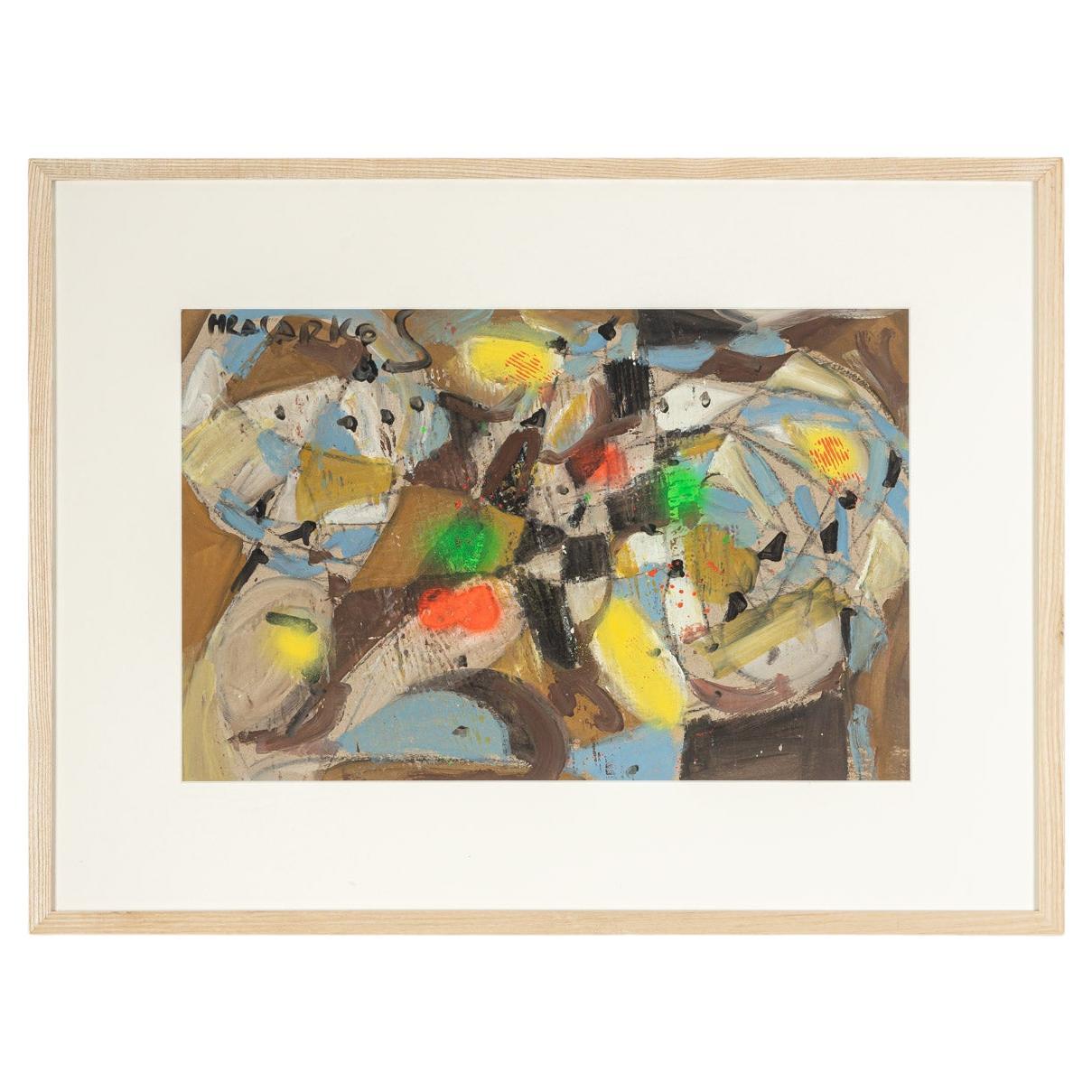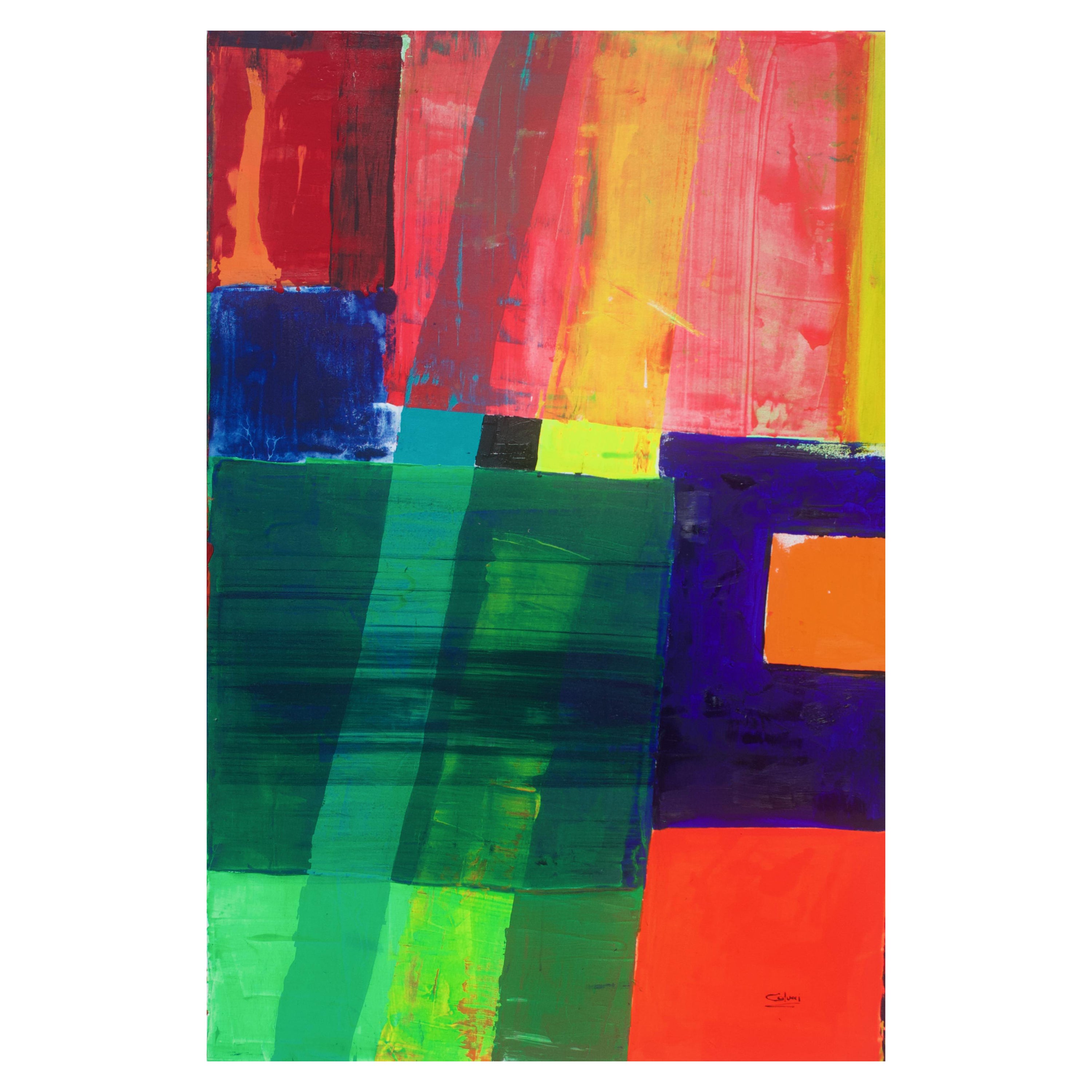Items Similar to Colorful Gouache "Abstract Dancing Nudes" by Gio Colucci
Want more images or videos?
Request additional images or videos from the seller
1 of 6
Colorful Gouache "Abstract Dancing Nudes" by Gio Colucci
About the Item
Gio Colucci, painter, sculptor, ceramist was born in Florence, Italy in 1892. In 1911, he moved to Paris to study architecture at the Fine Art School. Colucci settled in Cairo in 1914 where he worked as an architect. In 1917, he gave up architecture and began painting.
He went to the United States and brought back many canvas. Upon returning to Paris in 1919, Colucci exhibited at the Allard Gallery. In 1921 and 1923, he participated in the Salon d’Automne and in the Salon des Surindépendants with Gleizes, Herbin, Duchamp-Villon.
Colucci returned to Paris in 1945 and exhibited his ceramics at the Christofle Gallery. In 1947, he took part in the Salon des Décorateurs in Paris, and in 1952 exhibited his ceramics at the Vallauris Museum in Provence. The same year the Odéon Gallery exhibited his polychromed sculptures which have a total expression of liberty.
In 1954, Colucci participated in the Salon des Indépendants at the Grand Palais Museum where he showed sculptures and ceramics. Gio Colucci participated in the third Biennale dedicated to sculpture in 1955 in Antwerp in Belgium. In 1956, Colucci founded, along with Gino Severini, the Italian School of Arts and in 1959, a retrospective was held at the Juster’s Gallery in New York as well as at the Rodin Museum in Paris. A retrospective of his work is organized in New York in 1963. The Museum of Decorative Arts in Paris exhibited several polychromed wood-based sculptures, ceramics but also painted and sticked Arcopal glass by Colucci.
The artist died in Paris in 1974.
Provenance ex collection of Family owner of Sara Lee
- Creator:Gio Colucci (Artist)
- Dimensions:Height: 24.5 in (62.23 cm)Width: 23.25 in (59.06 cm)Depth: 2 in (5.08 cm)
- Materials and Techniques:
- Place of Origin:
- Period:
- Date of Manufacture:1950
- Condition:dimensions of work H: 17.5 W:14.75.
- Seller Location:Montreal, CA
- Reference Number:1stDibs: LU875113600042
About the Seller
4.8
Recognized Seller
These prestigious sellers are industry leaders and represent the highest echelon for item quality and design.
Gold Seller
These expertly vetted sellers are highly rated and consistently exceed customer expectations.
1stDibs seller since 2009
271 sales on 1stDibs
Typical response time: 1 hour
- ShippingRetrieving quote...Ships From: New York, NY
- Return PolicyA return for this item may be initiated within 7 days of delivery.
More From This SellerView All
- Colorful Abstract Gouache "Serpentine Shapes" by Gio ColucciBy Gio ColucciLocated in Montreal, QCGio Colucci, painter, sculptor, ceramist was born in Florence, Italy in 1892. In 1911, he moved to Paris to study architecture at the Fine Art School. Colucci settled in Cairo in 191...Category
Vintage 1950s Italian Paintings
MaterialsPaper
- Colorful Abstract Gouache "Lovers in Landscape" by Gio ColucciBy Gio ColucciLocated in Montreal, QCGio Colucci, painter, sculptor, ceramist was born in Florence, Italy in 1892. In 1911, he moved to Paris to study architecture at the Fine Art School. Colucci settled in Cairo in 191...Category
Vintage 1950s Italian Paintings
MaterialsPaper
- Colorful Still Life Painting by René ArnouxBy René ArnouxLocated in Montreal, QCColorful oil on canvas painting: Le "Poisson" by René Arnoux (1928-2009). Born in Tunisia in 1928 Arnoux moved to Paris in 1956. He also exhibited extensively Canada, the U.S.A. a...Category
Vintage 1960s French Paintings
- Painting of an Appeasing Nude by Adam Sherriff ScottBy Adam Sherriff Scott 1Located in Montreal, QCAdam Sherriff Scott was born in Perth, Scotland and began his art education in 1903 at the Edinburgh School of Art. He was awarded the Allen-Fraser Scholarship to continue his studies for four years at the Allen-Fraser institute, which was a finishing school for talented young artists, and studied under George Harcourt A.R.A. After this, he continued his studies at the Slade School under Henry Tonks as well as at the National Gallery and the Tate Gallery. In 1912, he moved to Canada. He worked for an American who commissioned him to paint large scenes of the Canadian West to sell to real estate agents. Scott moved to Montreal in 1915 He became a member of the Beaver Hall...Category
Vintage 1940s Canadian Paintings
MaterialsCanvas
- Watercolor of a Semi Nude Woman by Adam Sherriff ScottBy Adam Sherriff Scott 1Located in Montreal, QCProvenance from Estate of the son of Thomas Garside, who was a very closed friend of Sherriff-Scott. .Category
Vintage 1940s Canadian Paintings
MaterialsCanvas
- Colorful Oil on Canvas "Nature Morte Aux Fruits" by Claude VenardBy Claude VenardLocated in Montreal, QCClaude Venard, French painter (1913-1999).Colorful abstract cubist oil on Canvas "Nature Morte Aux Fruits ". Signed "C. Venard", label to the back May 9, 1989, lot 60 Provenance: Collection of Litsa Tsitsera, New York;, Christie's East, NY, May 9, 1989, lot 60, "Modern and Contemporary Paintings...Category
Vintage 1960s French Paintings
MaterialsCanvas
You May Also Like
- Colorful Fragmentation Gouache on Paper Framed Abstract Style Colorful MosaicLocated in Neuss, NWHrair Sakis KEUSSEYAN abstract painitng in a mosaic-style. Gouache on thick paper. Ready to hang, framed with a passepartout in an ash wood picture frame behind anti-reflective acryl...Category
Vintage 1980s Armenian Paintings
MaterialsAsh
- Monique Beucher. Gouache on paper. Abstract composition. Colorful palette.Located in Copenhagen, DKMonique Beucher (1934), French artist. Gouache on paper mounted on canvas. Abstract composition. Colorful palette. From the 1980s. In perfect condition. Exhibited at "La Galerie" 67 ...Category
Vintage 1980s French Paintings
MaterialsCanvas, Paper
- Mixed Media Painting by Steven ColucciBy Jackson PollockLocated in New York City, NYSteven Colucci’s iconoclastic approach to performance and the visual arts have not only long blurred the boundaries between these disciplines, but have challenged its most basic assumptions. The title of this show references a most rudimentary dance move --the plié --and our assumptions of what to expect in relation to this. Also the suggestion that we can simply press a button and a preconceived outcome will be courteously delivered --a form of prefabricated belief in itself. Steven Colucci’s artwork turns such basic assumptions on their heads. Finding early inspiration in the New York school of abstract expressionists such as Jackson Pollock with his action painting, and then further by his professor --a then young Vito Acconci while studying at the School of Visual Arts, Steven Colucci went from exploring the raw existentialist experimentation of New York’s early painting and performance scenes, to investigating the other end of the spectrum --the rigorously measured and controlled disciplines of pantomime and ballet; studying in Paris under the tutelage of world-famous Marcelle Marceau, and engaging with the concepts of dramatic movement pioneer and intellectual Etienne Decroux. Colucci has explained the difference between the extremes of pantomime and dance as being that pantomime forces movement via an internal capacity --movement directed inward to the core of one’s self --a source requiring extreme mental and physical control. Dance by contrast is an external expression; likewise requiring great precision, although instead an extension of self or sentiment that projects outwardly. While such historical ‘movement’ disciplines serve as foundation blocks for Steven’s artistic explorations, it is the realm in between that he is best known for his contributions --an experimental movement and performance art that simultaneously honors, yet defiantly refutes tradition; rejecting a compartmentalization regarding art and movement, yet incorporating its elements into his own brand of experimental pastiche. Colucci’s performance works manifest as eerily candy-coated and familiar, yet incorporate unexpected jags of the uncanny throughout, exploiting a sort of coulrophobia in the viewer; an exploration of a cumulative artifice that binds human nature against its darker tendencies; highlighting traditions of artifice itself - the fabricated systemologies that necessitate compartmentalization in the first place. It is evident in Steven Colucci’s paintings that he has established a uniquely distinctive pictorial vocabulary; a strong allusion to --or moreso an extension of --his performance works. Colucci’s paintings depict a sort of kinetic spectrum, or as he refers to them “a technical expression of physicality and movement”. Whereas the French performance and visual artist Yves Klein used the human body as a “paint brush” to demarcate his paintings and thereby signify a residue of performance, Colucci’s utilization of nonsensical numbers and number sequences taken from dance scores, as well as heat- induced image abstraction depicting traces of movement likewise inform his vocabulary. In the strand of the choreographed, yet incorporating moments of chance, Colucci’s paintings represent an over arching structure; a rhythm of being and state, yet detail erratic moments --moments that denote a certain frailty --the edge of human stamina. Colucci’s paintings dually represent a form of gestural abstraction --and also the reverse of this --a unique anthropomorphization of varying states of movement – that sometimes present as a temperature induced color field, at others are juxtapositions of movement and depictions of physical gestural images themselves. Colucci’s use of vernacular and found materials such as cardboard evoke his mastery of set design, and also reference a sort of collective experience of urbanity and the ephemeral. Such contradictions seem to permeate not only Steven Colucci’s artwork, but also are reflected in his person – one who grew up in New York’s Bronx during a zeitgeist moment in visual and performing arts in the 1960s – one who shifts with ease from happenings and experiments in New York City, to his meticulously choreographed megaproductions at Lincoln Center or starring in the Paris ballet...Category
2010s Paintings
MaterialsAcrylic
- Mixed Media Painting by Steven ColucciBy John ByardLocated in New York City, NYSteven Colucci’s iconoclastic approach to performance and the visual arts have not only long blurred the boundaries between these disciplines, but have challenged its most basic assumptions. The title of this show references a most rudimentary dance move --the plié --and our assumptions of what to expect in relation to this. Also the suggestion that we can simply press a button and a preconceived outcome will be courteously delivered --a form of prefabricated belief in itself. Steven Colucci’s artwork turns such basic assumptions on their heads. Finding early inspiration in the New York school of abstract expressionists such as Jackson Pollock with his action painting, and then further by his professor --a then young Vito Acconci while studying at the School of Visual Arts, Steven Colucci went from exploring the raw existentialist experimentation of New York’s early painting and performance scenes, to investigating the other end of the spectrum --the rigorously measured and controlled disciplines of pantomime and ballet; studying in Paris under the tutelage of world-famous Marcelle Marceau, and engaging with the concepts of dramatic movement pioneer and intellectual Etienne Decroux. Colucci has explained the difference between the extremes of pantomime and dance as being that pantomime forces movement via an internal capacity --movement directed inward to the core of one’s self --a source requiring extreme mental and physical control. Dance by contrast is an external expression; likewise requiring great precision, although instead an extension of self or sentiment that projects outwardly. While such historical ‘movement’ disciplines serve as foundation blocks for Steven’s artistic explorations, it is the realm in between that he is best known for his contributions --an experimental movement and performance art that simultaneously honors, yet defiantly refutes tradition; rejecting a compartmentalization regarding art and movement, yet incorporating its elements into his own brand of experimental pastiche. Colucci’s performance works manifest as eerily candy-coated and familiar, yet incorporate unexpected jags of the uncanny throughout, exploiting a sort of coulrophobia in the viewer; an exploration of a cumulative artifice that binds human nature against its darker tendencies; highlighting traditions of artifice itself - the fabricated systemologies that necessitate compartmentalization in the first place. It is evident in Steven Colucci’s paintings that he has established a uniquely distinctive pictorial vocabulary; a strong allusion to --or moreso an extension of --his performance works. Colucci’s paintings depict a sort of kinetic spectrum, or as he refers to them “a technical expression of physicality and movement”. Whereas the French performance and visual artist Yves Klein used the human body as a “paint brush” to demarcate his paintings and thereby signify a residue of performance, Colucci’s utilization of nonsensical numbers and number sequences taken from dance scores, as well as heat- induced image abstraction depicting traces of movement likewise inform his vocabulary. In the strand of the choreographed, yet incorporating moments of chance, Colucci’s paintings represent an over arching structure; a rhythm of being and state, yet detail erratic moments --moments that denote a certain frailty --the edge of human stamina. Colucci’s paintings dually represent a form of gestural abstraction --and also the reverse of this --a unique anthropomorphization of varying states of movement – that sometimes present as a temperature induced color field, at others are juxtapositions of movement and depictions of physical gestural images themselves. Colucci’s use of vernacular and found materials such as cardboard evoke his mastery of set design, and also reference a sort of collective experience of urbanity and the ephemeral. Such contradictions seem to permeate not only Steven Colucci’s artwork, but also are reflected in his person – one who grew up in New York’s Bronx during a zeitgeist moment in visual and performing arts in the 1960s – one who shifts with ease from happenings and experiments in New York City, to his meticulously choreographed megaproductions at Lincoln Center or starring in the Paris ballet...Category
2010s Paintings
MaterialsAcrylic
- "The Dancer Salute" Expressionist Gouache by Austino Obi OkaforLocated in Pasadena, CAStunning gouache painting of a dancer-like figure by the artist Austino Obi Okafor. "The dancer salute" gives the artwork a full expressive dimension with their long span stretching ...Category
Late 20th Century Nigerian Modern Paintings
MaterialsWood, Paper
- Abstract Gouache Painting by Hércules BarsottiLocated in Wiscasset, ME"Sem Titulo" gouache on paper. Illustrated Barsotti book page 146 Hércules Rubens Barsotti (born July 20, 1914 – December 21, 2010) was a Brazilian painter, graphic designer, s...Category
Vintage 1970s Brazilian Modern Paintings
Recently Viewed
View AllMore Ways To Browse
Colorful Wood Wall Art
Vintage Furniture Antwerp
Vallauris Decorative Wall
Used Furniture In Cairo
Antwerp School
Allards Used Furniture
Europa Painting
19th Century Oil Paintings Religious
Southwest Wall Art
Wall Decoration Random
French Provincial Oil
Picasso Painting Framed
Unknown Unsigned Painting
Pair Small 19th Century Paintings
16th Century Baroque
Antique Carriage Horse
Antique Horse Carriages
Antique Horse Carriage





